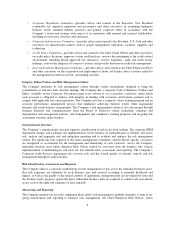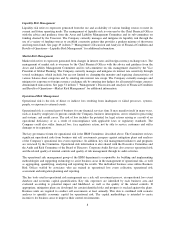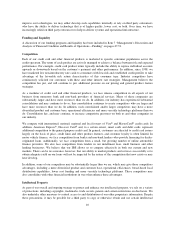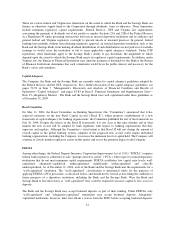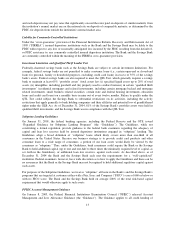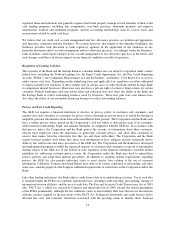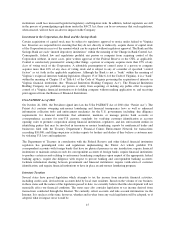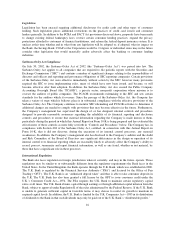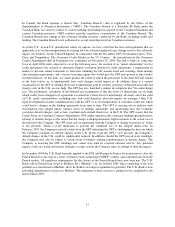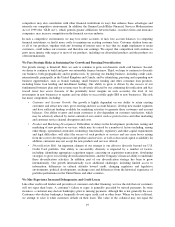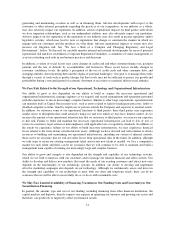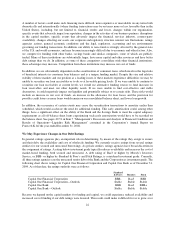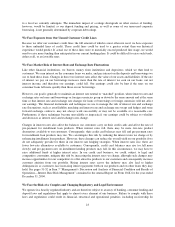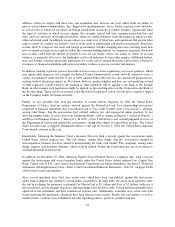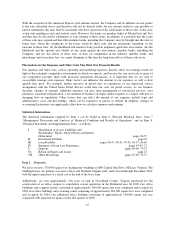Capital One 2004 Annual Report Download - page 39
Download and view the complete annual report
Please find page 39 of the 2004 Capital One annual report below. You can navigate through the pages in the report by either clicking on the pages listed below, or by using the keyword search tool below to find specific information within the annual report.Legislation
Legislation has been enacted requiring additional disclosures for credit cards and other types of consumer
lending. Such legislation places additional restrictions on the practices of credit card issuers and consumer
lenders generally. In addition to the FCRA and FACT Act provisions discussed above, proposals have been made
to change existing federal bankruptcy laws, restrict certain consumer lending practices, expand the privacy
protections afforded to customers of financial institutions, and reform the federal deposit insurance system. It is
unclear at this time whether and in what form any legislation will be adopted or, if adopted, what its impact on
the Bank, the Savings Bank, COAF or the Corporation would be. Congress or individual states may in the future
consider other legislation that would materially and/or adversely affect the banking or consumer lending
industries.
Sarbanes-Oxley Act Compliance
On July 30, 2002, the Sarbanes-Oxley Act of 2002 (the “Sarbanes-Oxley Act”) was passed into law. The
Sarbanes-Oxley Act applies to all companies that are required to file periodic reports with the Securities and
Exchange Commission (“SEC”) and contains a number of significant changes relating to the responsibilities of
directors and officers and reporting and governance obligations of SEC reporting companies. Certain provisions
of the Sarbanes-Oxley Act were effective immediately without action by the SEC; however many provisions
required the SEC to issue implementing rules, many of which have now been issued, and became, or will
become, effective after their adoption. In addition, the Sarbanes-Oxley Act also created the Public Company
Accounting Oversight Board (the “PCAOB”), a private sector, non-profit corporation whose mission is to
oversee the auditors of public companies. The PCAOB recommends rulemaking to the SEC and sets certain
standards for the auditors which it oversees. Since the passage of the Sarbanes-Oxley Act, the Company has
taken a variety of steps which it believes place it in substantial compliance with the effective provisions of the
Sarbanes-Oxley Act. The Company continues to monitor SEC rulemaking and PCAOB activities to determine if
additional changes are needed to comply with provisions that may become effective in the future. Furthermore,
the Company’s management has supervised the design of, or has designed, internal controls and procedures
designed to provide reasonable assurances regarding the reliability of its financial reporting and disclosure
controls and procedures to ensure that material information regarding the Company is made known to them,
particularly during the period in which this Annual Report on Form 10-K is being prepared and has evaluated the
effectiveness of those controls as more fully set forth in “Controls and Procedures” below. The Company has, in
compliance with Section 404 of the Sarbanes-Oxley Act, certified, in connection with this Annual Report on
Form 10-K, that it did not discover, during the execution of its internal control processes, any material
weaknesses. In addition, the Company’s management also has disclosed to the Company’s auditors and the Audit
and Risk Committee of the Board of Directors any significant deficiencies in the design or operation of its
internal control over financial reporting which are reasonably likely to adversely affect the Company’s ability to
record, process, summarize and report financial information, as well as any fraud, whether or not material, by
those that have a significant role in these processes.
International Regulation
The Bank also faces regulation in foreign jurisdictions where it currently, and may in the future, operate. Those
regulations may be similar to or substantially different from the regulatory requirements the Bank faces in the
United States. In the United Kingdom, the Bank operates through the U.K. Bank, which was established in 2000.
The U.K. Bank is regulated by the Financial Services Authority (“FSA”) and licensed by the Office of Fair
Trading (“OFT”). The U.K. Bank is an “authorized deposit taker” and thus is able to take consumer deposits in
the U.K. The U.K. Bank has also been granted a full license by the OFT to issue consumer credit under the
U.K.’s Consumer Credit Act—1974. The FSA requires the U.K. Bank to maintain certain regulatory capital
ratios at all times. The U.K. Bank obtains capital through earnings or through additional capital infusion from the
Bank, subject to approval under Regulation K of the rules administered by the Federal Reserve. If the U.K. Bank
is unable to generate sufficient capital in favorable terms, it may choose to restrict its growth to maintain its
required capital levels. In addition, the U.K. Bank is limited by the U.K. Companies Act—1985 in its distribution
of dividends to the Bank in that such dividends may only be paid out of the U.K. Bank’s “distributable profits.”
16


